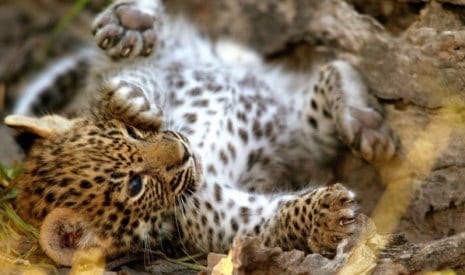Specimen of the Week 206: The leopard skull
By Will J Richard, on 21 September 2015
Hello! Will Richard here. Taking my turn to bring you another specimen of the week. And what can I say about this week’s specimen?
Very little… on with the blog!
This week’s specimen is…
**the leopard skull**
1) What I learnt
This was a genuine surprise to me, but the leopard (Panthera pardus) has an almost unbelievable range. The same species occurs throughout Sub-Saharan and West Africa, in pockets of North Africa, across the Middle East (including parts of Turkey), throughout Southwest and Southeast Asia, into the Himalayas, Eastern Russia, and even Sri Lanka and Indonesia. Let’s put it this way: you could walk from Cape Town to Beijing and you wouldn’t leave the leopard’s natural habitat… having said that, you probably wouldn’t see one!
There are nine recognised sub-species each with unique coat patterns (determined by the size, shape, density and colouring of the rosettes) and there are also naturally-occurring melanistic animals (black panthers) which thrive in denser forests. Leopards make a home in savannah, grasslands, swamps, rainforests, woodlands, deserts and even at high altitude. It’s worth noting that the snow leopard (P. uncia) is not one of the nine subspecies but is easily confused with the Amur leopard (P. p. orientalis), which is.
2) Protein shake
At the heart of this adaptability must be their willingness to eat almost anything. If they can catch it (or scavenge it) they will eat it and it doesn’t have to be fresh. Prey species range from beetles to baboons to buffalo and they will often store large kills for later, dragging carcasses up trees or burying them. They are the archetypal ambush predators, and will slowly stalk their prey to within a few metres before pouncing, hoping to incapacitate with an instantaneous neck-break (obviously less of a concern if you’re hunting a beetle). They are so accurate and powerful that they have been recorded successfully hunting prey ten times their own weight. A large male leopard weighs about 65 kilogrammes so could kill an animal weighing two-thirds of a tonne. The frequency of hunting obviously depends on the prey in question (few buffalos, many beetles) and a leopard needs to eat about three kilogrammes a day to maintain condition. They do seem to keep hunting regardless of the amount they’ve stored, however. Leopards are always looking out for the lean times ahead.
3) Having kittens
Unlike lions, these big cats live alone and prefer to do so. They will viciously defend territories against others of the same sex though a male’s territory will overlap with several females’ and vice versa. Both will have multiple partners. These assignations are brief but passionate: leopard lovers mate up to 100 times a day. Each copulation lasts only a few seconds with a six minute breather in between but couples only stay couples for a few days at most. If their time together has been fruitful the female will give birth to a small litter (usually two or three cubs) after a 14 week gestation period. The cubs are born blind and helpless but develop fast and are completely weaned three months later. They will remain with their mother for at least their first year or two, learning vital hunting and social skills from her and each other.

Leopard cub. Image by FrontierEnviro; CC-BY-SA-3.0; via Wikimedia Commons
4) It’s a cat eat cat world out there
Other than humans adult leopards have few natural predators (as cubs they are, of course, more vulnerable) but are occasionally killed by tigers and lions, hyenas, Cape hunting dogs, Burmese pythons and large crocodiles. While this is catastrophic for individual leopards, it doesn’t appear to impact the population as a whole. What is more of a concern is the intense competition for prey between leopards and these other big hunters. Perhaps the most direct comparison can be made between the leopard and the tiger (P. tigris) as both are solitary, primarily nocturnal, ambush predators. Interestingly, in areas where the two species coexist they have developed an equilibrium. Leopards shift to smaller prey, hunt at different times and avoid tiger hot-spots. Again flexibility seems to be at the heart of the leopard’s success.

Leopard in the long grass. Image by Greg Willis; CC BY-SA 2.0; via Wikimedia Commons
5) What big teeth you have…
A lot of this comes back to the skull. Leopards have big, broad heads for their body size, maximising the strength of their jaws. This allows them to prey on surprisingly large animals which will sustain them for a relatively long time or they need comparatively few smaller kills to keep going. To compare again: tigers need (approximately) double the daily nutritional intake to maintain condition, so will presumably be less resilient in times of shortage
…unless they eat the leopards…
References:
Hayward M.W. et al. (2006) Prey preferences of the leopard (Panthera pardus); Journal of Zoology; v270; i2; p.298-313
Seidensticker, J. (1976) On the ecological separation between tigers and leopards. Biotropica 8: p.225
Will Richard is Visitor Services Assistant at the Grant Museum of Zoology
 Close
Close



